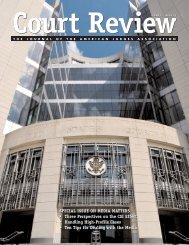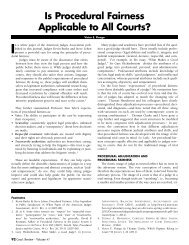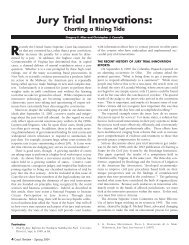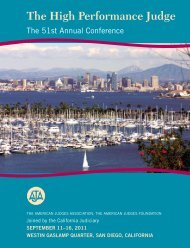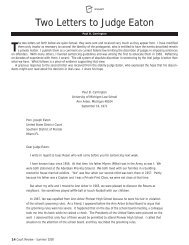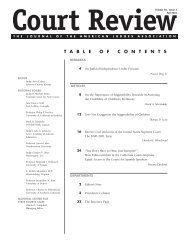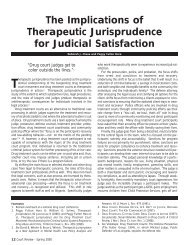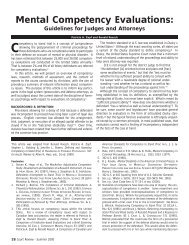Special Issue on Procedural Fairness - American Judges Association
Special Issue on Procedural Fairness - American Judges Association
Special Issue on Procedural Fairness - American Judges Association
- No tags were found...
Create successful ePaper yourself
Turn your PDF publications into a flip-book with our unique Google optimized e-Paper software.
up to the courtroom, but also the way the courtroom itself is c<strong>on</strong>ducted. Judicial officers and thosewho work with them are beginning to think of ways to manage the courtroom so that neutrality isenhanced by making the systems work for all, regardless of whether they have a lawyer. People whoappear pro se are more likely to be poor, a minority, and overwhelmed by the legal process.b. Some fear that changing court procedures to be friendly to the self-represented undercuts judicialneutrality. The <strong>American</strong> <strong>Judges</strong> Associati<strong>on</strong> is a member of the Self-Represented LitigantNetwork, which has resources.c. Courtroom procedures as a whole must be designed to support the type of relaxed neutral communicati<strong>on</strong>sbetween judges and self-represented litigants that is optimal for obtaining the factsnecessary <strong>on</strong> which to base high quality decisi<strong>on</strong>-making.3. Use the research cited in this paper to demand adequate numbers of judicial officers to be able to handlehigh-volume dockets in ways that both move the cases toward a timely dispositi<strong>on</strong> and allow thosecoming through the court to feel that they have been respected and listened to.4. C<strong>on</strong>sider how procedures may affect percepti<strong>on</strong>s of fairness. For example, providing a small-claimslitigant a written explanati<strong>on</strong>, even c<strong>on</strong>sisting of a few sentences, may be preferable to using a checkthe-boxform judgment. Or it may be that providing an oral decisi<strong>on</strong> from the bench will be seen asfairer than a cursory decisi<strong>on</strong> that arrives in the mail.WHAT CAN COURT ADMINISTRATORS DO?1. Share this paper with court employees. Engage them in a discussi<strong>on</strong> of the importance of fairness inour courts. As important as the judge may be in the process, the judge is just <strong>on</strong>e piece of the puzzlewhen it comes to the public’s interacti<strong>on</strong> with the court system. C<strong>on</strong>duct courtwide training sothat all employees understand the important role they play in providing procedural fairness. How litigantsare treated by court employees from the moment they enter the courthouse door—or themoment they encounter security pers<strong>on</strong>nel at a metal detector—sets the t<strong>on</strong>e.2. Make it a major project for 2008 to analyze the t<strong>on</strong>e of public interacti<strong>on</strong> that is set in your courthouse.Does it c<strong>on</strong>vey respect and care for the people who, often in stress, come there? Could it beimproved? Many courthouses have child-care facilities, adequate handicapped-accessible areas (nowrequired by the ADA), and domestic-violence waiting rooms. Are there improvements that should bemade at your courthouse? Involve all stakeholders (judges, staff, attorneys, litigants, and the generalpublic) in this process.3. Treat employees fairly. If court employees do not feel that they are fairly treated in their jobs by courtleaders, it is unlikely that they will treat the public any better. The Nati<strong>on</strong>al Center for State Courts’CourTools has a specific measurement tool for employee satisfacti<strong>on</strong>. Court administrators need tostrive to create a courthouse work envir<strong>on</strong>ment that doesn’t breed cynicism.4. Work to provide sufficient support staff so that judges are not distracted by activities that may interferewith their perceived attenti<strong>on</strong> to the presentati<strong>on</strong> of cases in the courtroom. For example, if ajudge is fiddling with tape recorders and making c<strong>on</strong>stant notes of tape counter numbers, that judgeis not going to be looking at the litigants and attorneys and is not going to be perceived as having paidcareful attenti<strong>on</strong> to the parties’ dispute. There are many roles that judges take <strong>on</strong> in understaffedcourts and courtrooms. Those roles should be carefully m<strong>on</strong>itored for possible interference with theCourt Review - Volume 44 19



